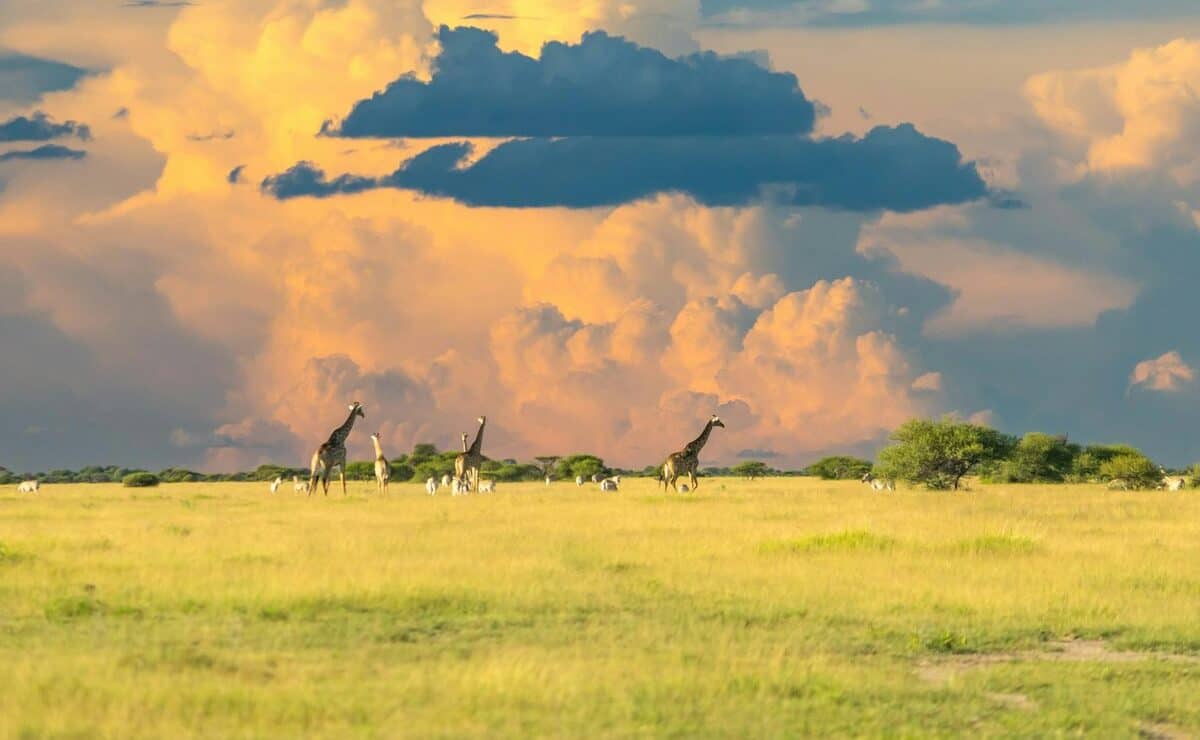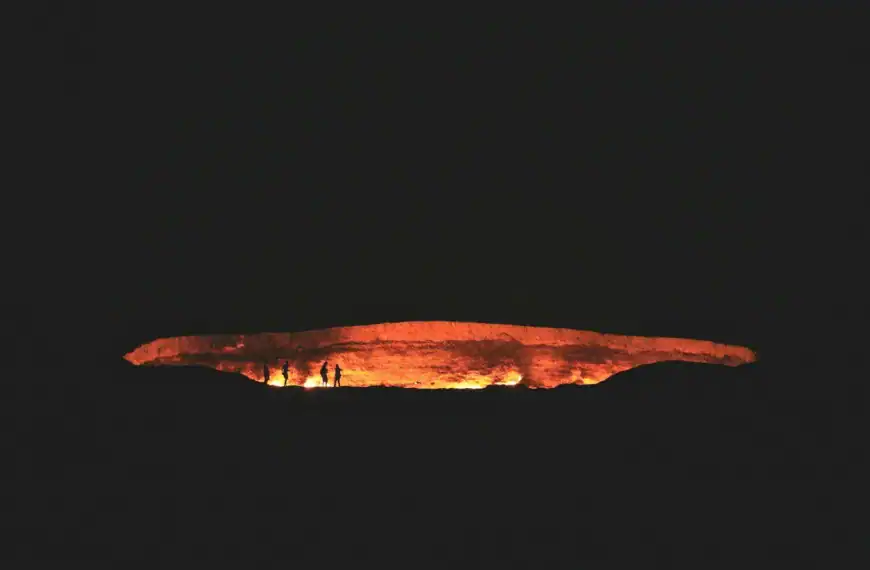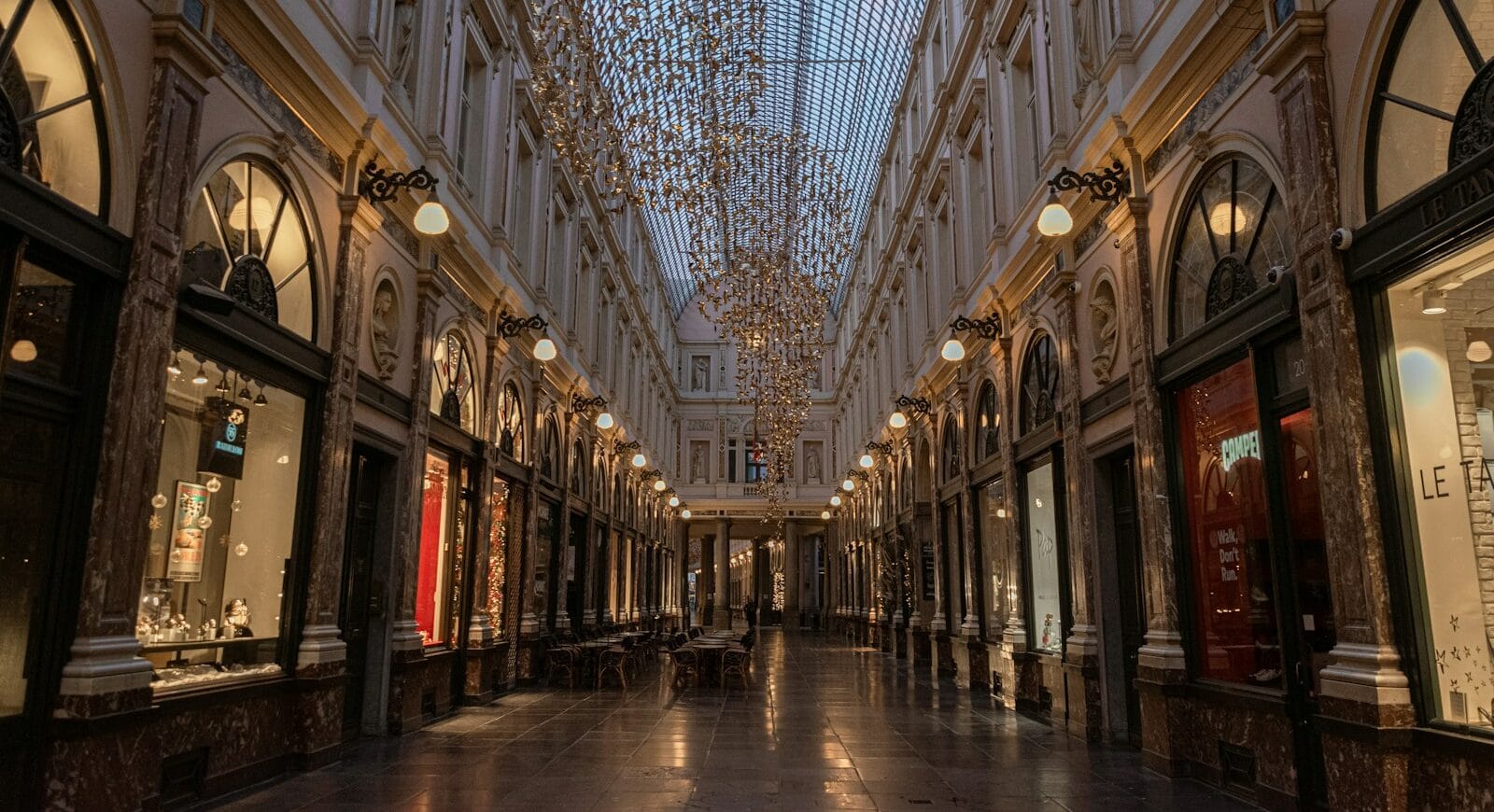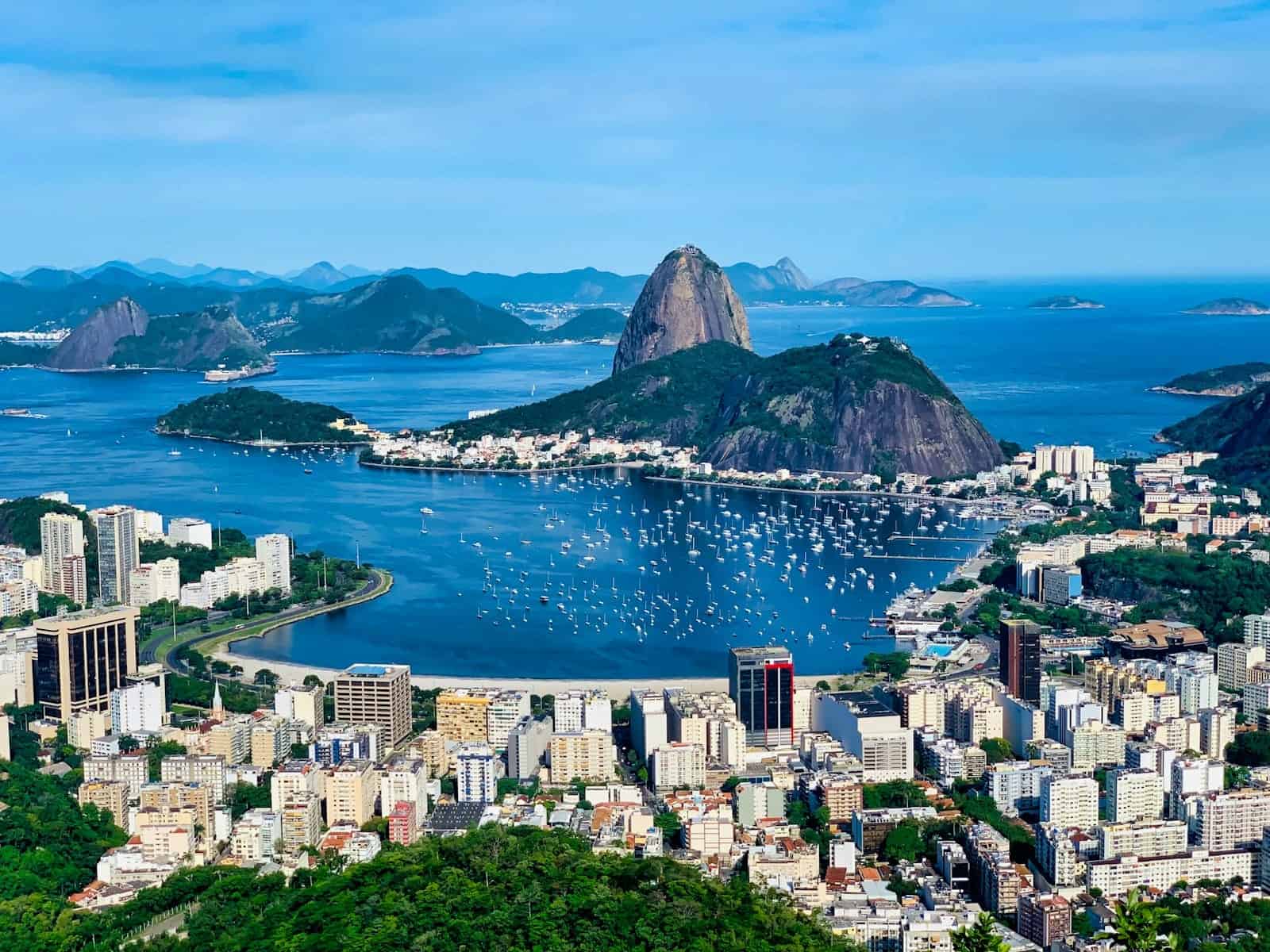Botswana Travel Guide: Wild Beauty & Delta Dreams
Intro to Botswana Travel Guide
A land of timeless skies, untamed wildlife, and uncharted luxury — Botswana is Africa’s quiet triumph. With one of the world’s largest inland deltas, protected wilderness that stretches for days, and a deep-rooted cultural heritage, Botswana rewards slow, immersive travel.
Whether tracking wild dogs in the Okavango, cruising past elephants on the Chobe, or sleeping beneath stars in the Kalahari, Botswana is an invitation to disconnect and rediscover the world through nature.
Start planning your journey with our complete Botswana Travel Guide — featuring regional breakdowns, safari circuits, and expert travel tips.
States and Territories of Botswana
Central District | Chobe District | Ghanzi District | Kgalagadi District | Kgatleng District | Kweneng District | Ngamiland District | North-East District | South-East District | Southern District
💡Quick Facts:
Destination: Botswana
Continent: Africa
Country: Botswana
Administrative Division: 10 administrative districts
City: Capital – Gaborone
Area: 581,730 km²
Population: ~2.8 million (2024 est.)
Density: ~5 people per km²
Capital: Gaborone
Regions/Subregions: Okavango Delta, Kalahari, Chobe, Central District, Ngamiland
Official & Regional Languages: English (official); Setswana (widely spoken)
Currency: Botswana Pula (BWP)
Time Zone(s): Central Africa Time (UTC+2)
Airports:
– Sir Seretse Khama Intl Airport (GBE) – Gaborone
– Maun Airport (MUB) – gateway to Okavango Delta
– Kasane Airport (BBK) – near Chobe National Park
Climate: Semi-arid; hot summers and mild winters
Known For: Okavango Delta (UNESCO), luxury safaris, Chobe wildlife, San culture, sustainable tourism
🛂Arrival Info:
Entry Requirements:
– Visa-free for most Western, SADC, and Commonwealth countries
– Valid passport (minimum 6 months)
Visa-Free Countries: U.S., EU, UK, Australia, Canada, South Africa, most African nations
Visa-on-Arrival: Not offered; check visa eligibility in advance
Maximum Tourist Stay: 90 days within a 12-month period
Electronic Travel Authorization: Not applicable currently
Visa Portal
Customs Info
💉Health Info:
Recommended Vaccines: Hepatitis A & B, Typhoid, Tetanus, Rabies (if wildlife exposure)
Health Advisories: Malaria risk in northern Botswana (Okavango, Chobe) — take precautions
Hospitals: Best facilities in Gaborone; limited services in remote areas
English-speaking Clinics: Private hospitals in Gaborone and Maun
Terrain-specific Concerns: Mosquitoes, heatstroke, waterborne diseases in floodplains
Insurance: Required for travelers; medevac coverage highly recommended
✅ Check travel insurance options for travel emergencies, delays, and medical needs abroad — Get coverage here
✅ Stay Informed with Official Updates: WHO – International Travel & Health | CDC – Travel health updates
🚨Travel Advisory:
Current Alerts: Minimal – generally very safe for travelers
General Safety Level: Level 1 – Exercise Normal Precautions
Regional Restrictions: Some remote parks require 4×4 access
Local Risks: Petty theft in urban areas; wildlife proximity risks in lodges
Civil Rights Concerns: Same-sex relationships not legally recognized
✅ Stay Informed with Official Updates: US Travel Advisory | UK Foreign Travel Advice
📅Holidays:
Major National Holidays:
– Independence Day (Sep 30–Oct 1)
– President’s Day (3rd Monday & Tuesday in July)
– Botswana Day (October 1)
Local Events:
– Maitisong Festival (April) – arts and performance in Gaborone
– Dithubaruba Cultural Festival (September) – Molepolole
💰Visitor Info:
Currency: Botswana Pula (BWP)
Exchange Tips: Use ATMs in cities; avoid street vendors
ATMs: Available in cities and tourist towns (Maun, Kasane)
Cards: Credit/debit cards widely accepted in hotels, lodges, and restaurants
Tipping: 10–15% in service industries; safari guides: $10–$20 per day
Tourist Taxes: Botswana Tourism Levy (currently suspended but subject to return)
Daily Budget:
– Budget: $60–$100 USD
– Midrange: $150–$300 USD
– Luxury: $500+ USD (for private lodges or fly-in safaris)
✈️Airports:
Main Airports:
– Sir Seretse Khama Intl (GBE) – Gaborone
– Maun Airport (MUB) – Okavango access
– Kasane Airport (BBK) – gateway to Chobe National Park
International Connections: Flights from Johannesburg, Cape Town, Nairobi, Addis Ababa
Transport to Cities:
– Taxis, car rentals, pre-booked transfers
✅ Delayed or canceled flight? Check if you’re eligible for compensation
🚍Transport:
Local: Minibuses, taxis in Gaborone; walking in small towns
Intercity: Coaches (e.g., Seabelo, Intercape); air travel to safari zones
Driving Laws: Left-hand side; IDP recommended
Rental Cars: Available in Gaborone, Maun, and Kasane
Scams: Very limited; country is low-corruption and safe for tourists
✅ Book reliable airport transfers and in-city rides in advance. Reserve your ride here
📶Connectivity:
SIM/eSIM: Mascom, Orange Botswana, BTC — available at airport or shops
Mobile Coverage: Good in towns; limited in parks or lodges
Public Wi-Fi: Available in hotels and cafés in Gaborone and Maun
Roaming: Expensive; local SIMs recommended for data access
✅ Stay connected abroad with affordable eSIM data packs. Get your eSIM here
📜Laws & Etiquette:
Drinking Age: 18+
Alcohol: Legal; sold in licensed outlets only
LGBTQ+ Status: Decriminalized but not widely accepted in rural areas
Etiquette: Respectful greetings expected; modest dress in villages
Cultural Taboos: Avoid taking photos of locals without permission
Photography Rules: Drones restricted in national parks; permits may be required
🛡️Emergency Info:
Emergency Numbers:
– Police: 999
– Ambulance: 997
– Fire: 998
Tourist Support: Botswana Tourism Organisation
U.S. Embassy: Gaborone
Tourist Police: Present in major parks and towns
✅ Use embassy locator tools: Embassies Worldwide
🌦️Weather:
Climate Type: Semi-arid with a summer rainy season
Best Time to Visit: May–October (dry season, best for safaris and wildlife visibility)
Rainy Season: November–March – green landscapes, birding season
Average Temps:
– Summer: 25–35°C (77–95°F)
– Winter: 5–25°C (41–77°F), colder at night
✅ Stay prepared—check the weather forecast for your destination — Weather Forecast
Botswana by Region – Where to Go
Botswana has 10 administrative districts, each offering distinct safari routes, landscapes, and cultural touchpoints. Use this regional guide to map your perfect itinerary.
Central District
Serowe & Palapye – Cultural strongholds and colonial history at the heart of Botswana’s tribal heritage.
Makgadikgadi Pans – Vast salt flats, baobab groves, and surreal desert beauty.
Chobe District
Kasane – Safari town hub with boat access to Chobe National Park.
Chobe Riverfront – Legendary for dense elephant herds and river-based game viewing.
Ghanzi District
Ghanzi – Gateway to the Kalahari with San communities and desert-adapted wildlife.
Central Kalahari Game Reserve (north) – Remote wilderness for self-drive adventures and quiet camps.
Kgalagadi District
Tsabong – Near the Kgalagadi Transfrontier Park’s southern entrance.
Khawa Dunes – Ideal for off-road driving and desert festivals.
Kgatleng District
Mochudi – Cultural village home to the Bakgatla people and traditional art.
Oodi – Famous for handwoven baskets and local cooperatives.
Kweneng District
Kanye – Historic village in the hills, close to natural rock formations.
Molepolole – A spiritual and cultural center with traditional healing sites.
Ngamiland District (North-West)
Maun – Botswana’s adventure capital and launch point for the Okavango Delta.
Moremi Game Reserve – The jewel of the delta with predator-rich floodplains.
North-East District
Francistown – Former gold town with heritage sites and gateway to Zimbabwe.
Tachila Nature Reserve – A conservation area close to the city.
South-East District
Gaborone – The capital blends diplomacy, culture, and business.
Oodi Hills – Scenic landscapes just outside the city.
Southern District
Lobatse – Colonial architecture and meat industry roots.
Moshupa – Picturesque village framed by balancing boulders and granite ridges.
Top Places to Visit in Botswana
From the famed Okavango to hidden Kalahari gems, these are the most iconic and inspiring places to visit in Botswana — grouped by travel experience.
Safari Icons and Riverfront Reserves
- Okavango Delta (Ngamiland) – A UNESCO World Heritage Site and one of Earth’s most unique ecosystems. Explore by mokoro (dugout canoe), 4×4, or fly-in safaris. Wildlife includes lions, leopards, and endangered sitatungas.
- Moremi Game Reserve (Ngamiland) – This protected core of the delta offers year-round game viewing, predator activity, and lush floodplains. It’s a favorite for high-end mobile safaris.
- Chobe National Park (Chobe) – Home to the world’s largest elephant population, Chobe River safaris deliver jaw-dropping animal scenes with dramatic sunset backdrops.
Desert and Salt Pan Landscapes
- Makgadikgadi Pans (Central) – A lunar-like salt desert where zebra migrate across cracked crusts and meerkats pose under open skies. Stay in eco-lodges or camp beneath ancient baobabs.
- Nxai Pan National Park (Central) – Seasonal waterholes attract thousands of zebras and springbok — and lions follow. The Baines’ Baobabs are a photographic treasure.
- Central Kalahari Game Reserve (Ghanzi) – One of the most remote reserves in Africa, with black-maned lions and San bushman experiences. Raw, quiet, and vast.
Cultural Towns and Southern Trails
- Serowe (Central) – Historical seat of Botswana’s Khama dynasty with cultural museums and tribal storytelling.
- Francistown (North-East) – A mining town with colonial roots, craft markets, and local reserves nearby.
- Gaborone (South-East) – Botswana’s modern face, with art galleries, hill hikes, and cultural institutions like the National Museum.
Discover top-rated Botswana tours and experiences, and explore the best things to do in Botswana — from delta canoe rides and lion tracking to salt pan sleepouts and San bushwalks. Book early for exclusive access and flexible cancellation.
How to Choose Where to Go in Botswana
Botswana is a low-impact, high-value destination. Most travelers focus on 2–3 key areas due to cost and remoteness. Here’s how to choose:
- For Classic Safari & River Wildlife: Combine Chobe and the Okavango Delta via Maun or Kasane.
- For Remote, Desert Adventure: Explore the Central Kalahari and Makgadikgadi for starry nights and vast silence.
- For Cultural Insight: Visit Serowe or Ghanzi to learn about Botswana’s tribal legacies and San traditions.
- For Budget or Independent Travel: Gaborone, Francistown, and the pans offer more accessibility and local transport.
Efficient pairings include:
- Chobe + Delta + Makgadikgadi (fly-in)
- Kalahari + Serowe + Francistown (road trip)
- Gaborone + Southern towns + Mokolodi Nature Reserve (short stays)
How to Get Around Botswana
Botswana is vast and mostly rural — so transport choices depend on time, budget, and route.
- Fly-In Safaris: The fastest way to reach remote parks. Light aircraft flights run from Maun and Kasane to private camps and airstrips.
- Self-Drive: Ideal for experienced overlanders. A 4×4 is essential for parks and pans. Roads are unpaved outside cities.
- Guided Tours: Common for mid-to-luxury safaris, with transfers, meals, and activities included.
- Public Transport: Buses connect major towns like Gaborone, Maun, Francistown, and Serowe. No public access to most parks.
- Car Rentals: Available in cities and at airports. Plan fuel stops — distances are long and stations scarce in remote areas.
Kasane and Maun are top entry points for park access. Always check park rules, road conditions, and weather forecasts before setting out.
Travel Budget and Costs in Botswana
Botswana emphasizes quality over quantity. Costs reflect exclusivity, conservation fees, and logistics in remote areas.
- Budget: $60–100/day — limited options, mostly around towns or self-camping
- Mid-Range: $250–400/day — lodges, guided safaris, some fly-in links
- Luxury: $700–1,500+/day — private tented camps, flights, full-service safaris
Sample Prices:
- Light aircraft flight (one-way): $150–350
- Park entry: $10–30/day
- Budget guesthouse in Maun: $50–80/night
- Luxury lodge (all-inclusive): $800+/night
- Local meal: $4–10
Money-Saving Tips:
- Travel in green season (Nov–March) for lower rates
- Choose overland tours over fly-ins
- Focus on one region to reduce transport costs
- Camp at public sites in Makgadikgadi or Khutse Reserve
Best Time to Visit Botswana
Botswana’s seasons shape your experience — from flooding deltas to dry desert heat.
May to October – Dry Season (Peak Safari)
- Clear skies, cool nights, and thinning vegetation improve wildlife visibility.
- Okavango is in full flood; game gathers at rivers and pans.
- Best for Chobe, Moremi, and Central Kalahari safaris.
November to March – Green Season (Low Cost)
- Rain brings greenery, migratory birds, and newborn animals.
- Wet roads may limit access to remote parks.
- Great for budget travelers and photographers.
April & November – Shoulder Months
- November: start of rains, elephant concentrations still strong.
- Good compromise of value and wildlife.
- April: end of rains, blooming landscapes.
Must-See Experiences in Botswana
These unforgettable things to do in Botswana highlight its wild soul, thoughtful tourism model, and living traditions.
Glide Through the Okavango Delta
Explore the flooded delta by mokoro — a traditional dugout canoe steered by local polers. Expect serene channels, papyrus walls, and close-up views of hippos, birds, and elephants.
Cruise the Chobe River at Sunset
Board a riverboat from Kasane and float past elephants, buffalo, and crocs while sipping sundowners. Chobe’s golden hour is pure safari magic.
Sleep Under the Stars in the Kalahari
Camp deep in the Central Kalahari for total silence, epic starscapes, and the distant roar of black-maned lions.
Walk with San Bushmen
In Ghanzi or Deception Valley, join San guides to learn survival skills, foraging, storytelling, and the spiritual meaning of the land.
Watch the Zebra Migration
Each rainy season, thousands of zebra move from the Boteti River to Makgadikgadi and back — Africa’s longest terrestrial migration.
Track Predators in Moremi
Game drives in the heart of the Okavango often reveal leopards in trees, wild dogs on the hunt, and hyenas slinking through dusk.
Explore Baines’ Baobabs
This iconic cluster of giant trees on a salt pan island is both photographic and spiritual. Camp nearby for haunting sunset views.
Visit Gaborone’s Art Scene
Explore the Thapong Visual Arts Centre and local galleries in the capital — a modern counterbalance to the wilds.
Best Travel Itineraries in Botswana
Here are curated travel routes to help build your trip by interest and timeframe.
7-Day Delta & Chobe Explorer
- Day 1–2: Arrive in Maun, overnight lodge
- Day 3–4: Moremi mobile safari or lodge stay
- Day 5–6: Fly to Kasane, river cruise and Chobe game drives
- Day 7: Return to Maun or cross into Zimbabwe
10-Day Wild North Adventure
- Day 1–3: Fly into Maun, Okavango Delta by mokoro
- Day 4–5: Moremi or Khwai region 4×4 safaris
- Day 6–7: Road or flight to Savuti (dry plains & big cats)
- Day 8–10: Chobe Riverfront lodges + boat safaris
12-Day Desert + Culture Loop
- Day 1–2: Gaborone cultural walks + art
- Day 3–4: Drive to Serowe and Khama Rhino Sanctuary
- Day 5–7: Kalahari camping with San bushmen
- Day 8–10: Makgadikgadi salt pan sleepout
- Day 11–12: Return to Maun or connect to Kasane
Each route can be scaled up or down with added fly-ins, extensions to Namibia or Zimbabwe, or custom stopovers.
Local Cuisine and Culinary Experiences
Botswana’s food reflects its cattle heritage, seasonal farming, and desert simplicity. Meals are communal, hearty, and often meat-heavy.
Famous Dishes
- Seswaa – Slow-cooked shredded beef, often served with maize porridge (pap)
- Bogobe – Sorghum or maize porridge, plain or flavored with sour milk
- Morogo – Leafy greens sautéed with onion or tomato
- Vetkoek – Fried dough stuffed with mince or jam
- Phane – Dried caterpillars (protein-rich delicacy), typically fried
Where to Eat
- Gaborone: Try Main Deck or Sanitas Tea Garden for modern Motswana meals.
- Maun: The Duck Cafe for riverside dining and local specials.
- Kasane: The Old House for riverfront eats and safari lodge cuisine.
- Camps: Most safari lodges offer full board with Western and local menus — some include traditional dinners with music and firelight.
While not a food tourism hotspot, Botswana’s culinary culture reveals plenty about resilience, community, and seasonal living.
Travel Safety and Cultural Etiquette in Botswana
Botswana is among the safest and most stable countries in Africa — with excellent conservation ethics and welcoming locals.
Safety Guidelines
- Crime is low, especially in rural or safari zones. Exercise basic caution in cities.
- Stick with guides in wildlife areas — elephants and hippos wander freely.
- Roads can be sandy, unlit, and remote. Carry spares, water, and GPS.
- Malaria risk exists in the north — take antimalarials and use nets/repellent.
Cultural Etiquette
- Greeting elders with a handshake and nod shows respect.
- Dress modestly in villages or towns — especially women.
- Ask before taking photos of people or homes.
- Be patient — Botswana operates on a slower, relationship-based rhythm.
- Tipping is customary in lodges and for guides (around 10%).
English is widely spoken, but basic Setswana greetings like Dumela (hello) go a long way.
Where to Go Next – Pair Botswana with These Destinations
Botswana shares seamless safari circuits with several neighbors:
- Zimbabwe: Just across the Chobe River — extend to Victoria Falls or Hwange.
- Namibia: Explore the Caprivi Strip or Etosha after a Delta trip.
- South Africa: Fly from Gaborone or Maun to Johannesburg for urban contrast.
- Zambia: Cross from Kasane to Livingstone for Victoria Falls and cultural depth.
- Mozambique: Via southern border, add Indian Ocean beaches post-safari.
Looking for more? Check out more travel guides to help complete your itinerary for the region.
Journey Through Zimbabwe’s Wonders | Namibia Desert & Dune Adventures | Explore South Africa’s Diverse Landscapes | Zambia Safari & Waterfall Escapes
Final Planning Checklist for Botswana
- Lock in your itinerary early — camps book out 6–12 months ahead
- Secure fly-in routes or self-drive plans and permits
- Get yellow fever proof (if entering from a country with risk)
- Pack neutral clothing for safaris (avoid blue/black due to tsetse flies)
- Bring refillable bottles — many lodges offer filtered water
- Buy a local SIM (Mascom or Orange) if traveling independently
- Travel light — most safari flights have strict luggage limits
- Carry USD or BWP for tips, park fees, and small expenses
- Learn about low-impact travel — Botswana emphasizes sustainability
Inspired to explore Botswana’s vast wilderness and deep traditions? Visit our homepage for expert trip guides, tour suggestions, and planning tools for Africa’s most exclusive safari destination.










